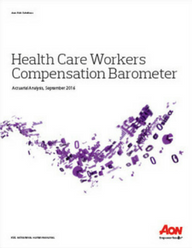2016 Health Care Workers’ Compensation Barometer Report
2017 expected to bring emerging risks, complex workers’ compensation claims for health care systems
The third edition of Aon’s biennial Health Care Workers’ Compensation Barometer report, which explores trends in frequency, severity and overall loss rates related to workers’ compensation in the health care industry. The report finds that for the 2017 accident year, health care systems will face a complex environment of emerging risks that will have a direct impact on workers’ compensation.
Download the 2016 Health Care Workers’ Compensation Barometer Report
View the full press release.
Other noteworthy key findings from Aon’s report include:
Aging Workforce
Data from Aon’s 2016 Health Care Barometer report finds that workers’ compensation claim costs increase as health care workers age, with the majority of those claims resulting from injuries to the back and shoulders. Fifty three percent of working nurses – a demographic that is the most frequently injured – are over the age of 50. A likely consideration for controlling these types of claims in the future and ensuring a healthy and safe workforce is education, specifically mentoring of the younger nursing population. While the report found that 58 percent of respondents have a program that develops younger workers, 61 percent do not have policies or programs that help transition older workers to a different work setting.
Safe Patient Handling
While loss prevention was the area of most concern for respondents, safe patient handling policies and controls are also top-of-mind in regards to minimizing risk of injury to health care workers. The report’s findings suggest that focusing on patient handling initiatives and best practices can prevent workers’ compensation claims, thus mitigating both concerns. The average cost of a claim for systems that use Safe Patient Handling and Mobility standards is lower versus a facility that does not – $6,000 versus $7,800 – and overall these standards have reduced the incidence of health care worker injuries by up to 95 percent.
Workplace Violence
An alarming number of survey respondents – 91 percent – have experienced workplace violence in the past three years. However, approximately half of respondents indicate they are prepared for such an incident, with another 27 percent being very prepared. Eighty-one percent of respondents have a formal Workplace Violence Prevention Policy in place.
Dominic Colaizzo, chairman and U.S. Health Care practice leader for Aon Risk Solutions added, “While we recognize these emerging risks that are facing our industry in the year ahead, we also see that health care systems are ahead of the game. They are adhering to standards and utilizing best practices that are no doubt having a direct, positive effect on the number of workers’ compensation claims.”
Historical trends by State
Aon’s Health Care Barometer report also provides statistical information on historical frequency, severity, and overall loss rates specific to 11 states. Notably, the report finds that loss rates in California are almost double the countrywide rate and that claims severity is nearly three times that of the countrywide average of $23,950.
If you elect to comment or engage with our content via third-party social media websites, you authorize Aon to have access to certain social media profile information. Please click here to learn more about information that may be collected when using these tools on Aon.com




